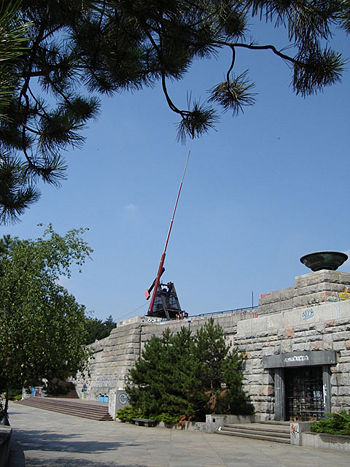Metronome, Letna Hill: Difference between revisions
Jump to navigation
Jump to search

imported>Louise Valmoria ({{subpages}}) |
imported>Louise Valmoria (insert pic) |
||
| Line 1: | Line 1: | ||
{{subpages}} | {{subpages}} | ||
The '''Metronome on Letna Hill''' is a large reverse pendulum, built in 1991 by David Cerný. It marks the position upon which the largest statue of Josef Stalin leading a pack of peasants and workers was built (removed in 1962). The length of the metronome is 15.5 metres, the height of the original statue, and at its base lies the remnants of the statue's original foundations. The pedestal itself is still referred to as Stalinuv pomnik (Stalin's Monument), although it is more commonly known to foreign tourists as the Metronome. | The '''Metronome on Letna Hill''' is a large reverse pendulum, built in 1991 by artist [[David Cerný]]. It marks the position upon which the largest statue of Josef Stalin leading a pack of peasants and workers was built (removed in 1962). The length of the metronome is 15.5 metres, the height of the original statue, and at its base lies the remnants of the statue's original foundations. The pedestal itself is still referred to by locals as Stalinuv pomnik (Stalin's Monument), although it is more commonly known to foreign tourists and in guidebooks as the Metronome. | ||
[[Image:PragueMetronome.jpg|right|thumb|350px|{{#ifexist:Template:PragueMetronome.jpg/credit|{{PragueMetronome.jpg/credit}}<br/>|}}Add Metronome from the base of the statue.]] | |||
Revision as of 00:48, 16 March 2008
The Metronome on Letna Hill is a large reverse pendulum, built in 1991 by artist David Cerný. It marks the position upon which the largest statue of Josef Stalin leading a pack of peasants and workers was built (removed in 1962). The length of the metronome is 15.5 metres, the height of the original statue, and at its base lies the remnants of the statue's original foundations. The pedestal itself is still referred to by locals as Stalinuv pomnik (Stalin's Monument), although it is more commonly known to foreign tourists and in guidebooks as the Metronome.
